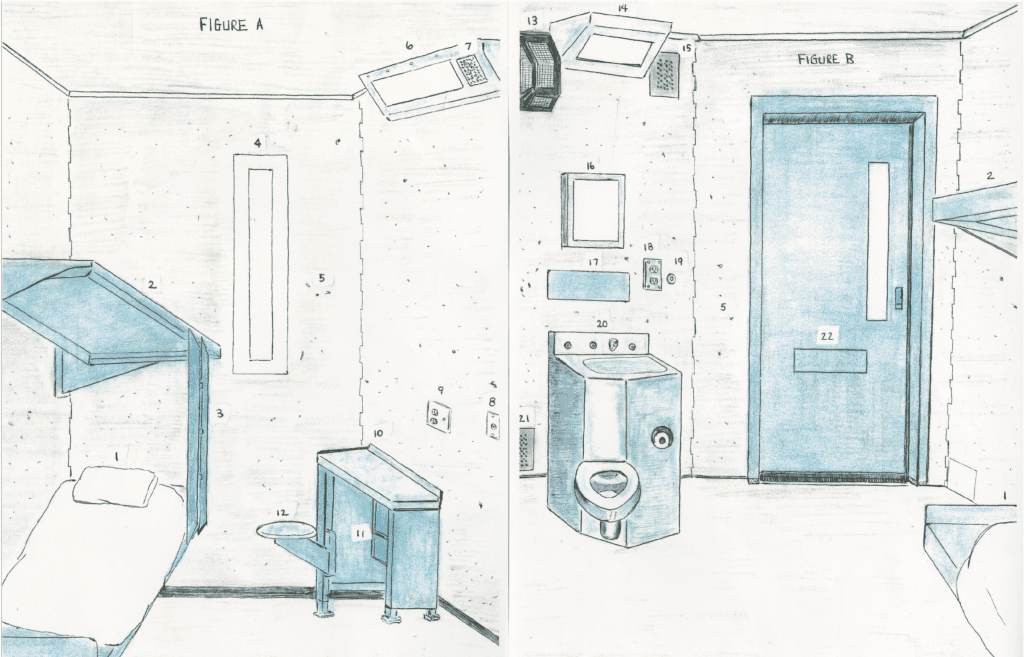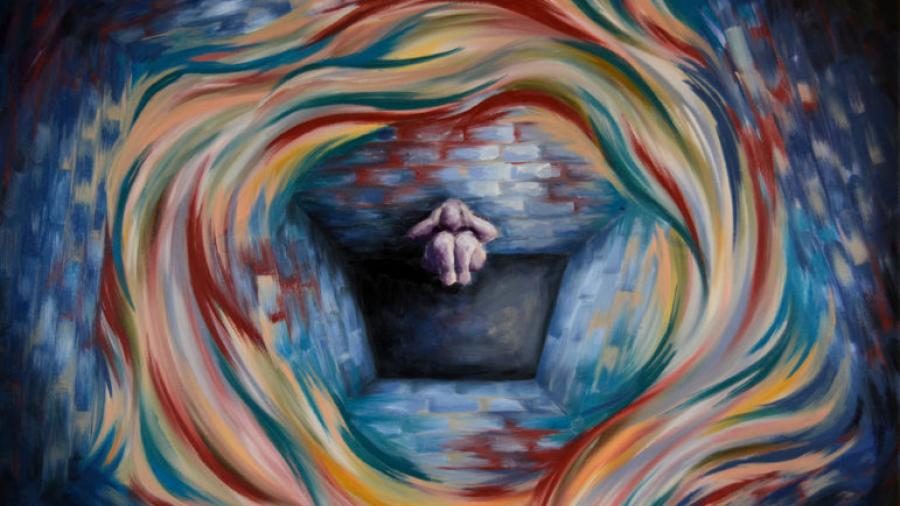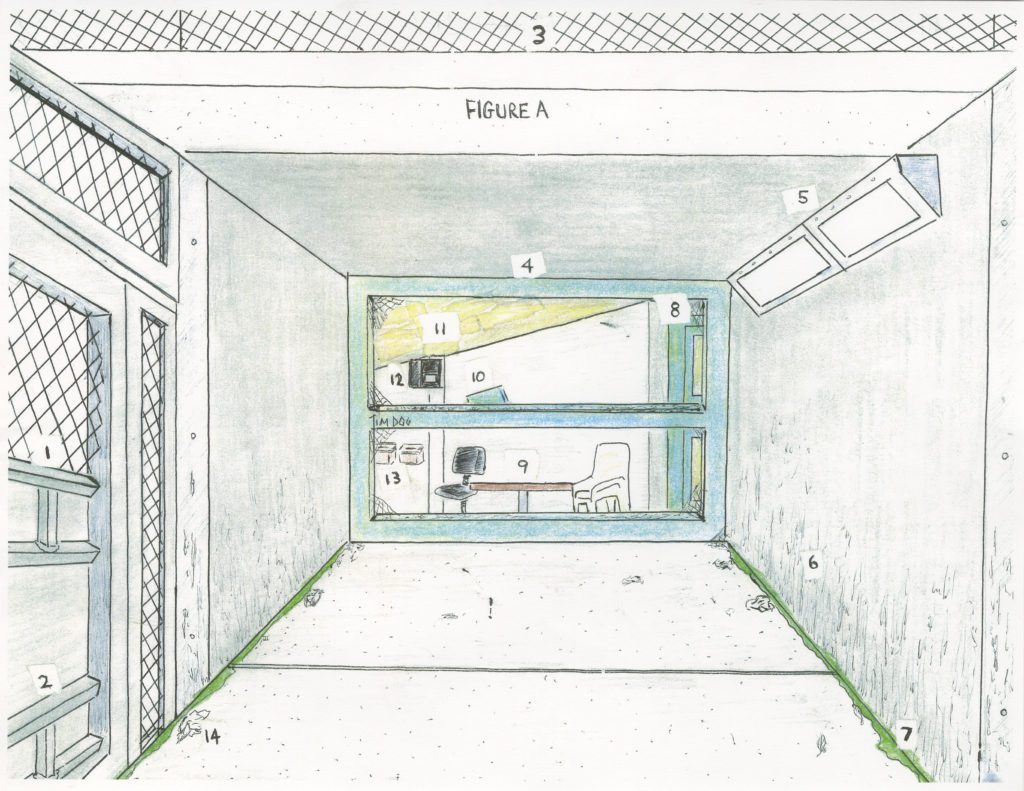LEARN MORE ABOUT
TORTURE
SOLITARY

Solitary Cell by Carnell Hunnicutt, Sr., Northern Correctional Institution, Connecticut, 2014 (solitary survivor)
WHY IS SOLITARY CONSIDERED TORTURE?
- Solitary confinement leads to irreversible psychiatric harm and brain damage and reduces the likelihood of a successful reentry after incarceration.
- People in solitary confinement often experience sensory deprivation.
- Solitary confinement decreases access to medical care and mental health care.
- Solitary confinement increases a person’s likelihood of committing violence.
- Solitary confinement can cause long-term Post Traumatic Stress Disorder (PTSD).

Solitary Confinement by anonymous solitary survivor. From Drawing Alone: Making Art in Solitary Confinement and Art and Art Therapy with the Imprisoned: Recreating Identity
Play Video
PBS Frontline tells the history of the United States’ criminal justice system and how the U.S. became a world leader in solitary confinement and mass incarceration.
History of Solitary Confinement in the United States
The United States began using solitary confinement in the late 1700s. Early in its use, solitary confinement proved harmful and could even lead to death. Until the late twentieth century, the use of solitary confinement was rare. But, beginning in the 1970s, solitary confinement increased with mass incarceration. By the early 2000s, solitary confinement was a routine practice in U.S. prisons and jails.
Solitary: A Virtual Experience
The national Unlock the Box campaign to end solitary confinement collaborated with The Guardian, Solitary Watch, and survivors of solitary confinement to create the “6×9: A Virtual Reality Experience.”
A mobile app allows you to experience ”6×9” on your own, with or without a VR viewer. If you don’t have a smartphone, scroll down to watch the 360° video.
Download the app for the full virtual experience:
The many names of solitary confinement
United States correctional facilities commonly use solitary confinement for many purposes but under a variety of pseudonyms, including administrative segregation, segregated housing units (SHU), restrictive housing, disciplinary segregation, protective custody, medical stay-in-place or lockdown, room confinement, safe cells, or suicide watch.
- Restrictive Housing and Administrative Segregation are common general terms for solitary confinement.
- Disciplinary Segregation is the use of solitary confinement as punishment.
- Room Confinement is the term used when children are held in solitary confinement.
- Protective Custody can be voluntary or involuntary. People who identify as transgender are often placed in solitary under this name due to facility units often being split by the gender binary of male and female.
- Medical Stay-in-Place is for medical emergencies such as an outbreak of a communicable disease. However, correctional facilities used COVID-19 to hold people in prolonged solitary confinement.
- Safe Cells are “suicide prevention cells” for people who are experiencing mental health crises and suicidal ideation. However, they are the antithesis of therapeutic spaces necessary for recovery.

Solitary Cell by Carnell Hunnicutt, Sr., Northern Correctional Institution, Connecticut, 2014 (solitary survivor)
lasting effects
effects on the brain
- Solitary confinement can lead people to experience hallucinations and psychosis.
- Social and sensory deprivation can cause memory loss and depression and impair cognition.
- Studies show that solitary confinement shrinks the part of the brain that helps store memories.
- Thirty-three percent of people in solitary confinement for at least 15 days become psychotic and/or suicidal.
- Solitary increases the likelihood of self-harm.
- Common symptoms of solitary confinement include panic attacks, paranoia, and sensitivity to sound.
long term damage
- People who spend any time in solitary confinement have an increased risk of dying from opioid overdose, cardiovascular disease, homicide, or suicide.
- People with more than one stay in solitary confinement are 129 percent more likely to commit suicide than those who have never spent time in solitary.
- People can lose their sense of self, become unable to connect to reality or have difficulty controlling their behavior.
- People held in solitary confinement, for any amount of time, are more likely to return to prison shortly after their release than those who were never held in solitary .
